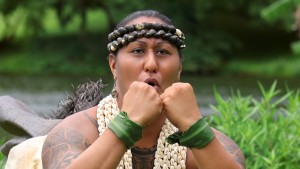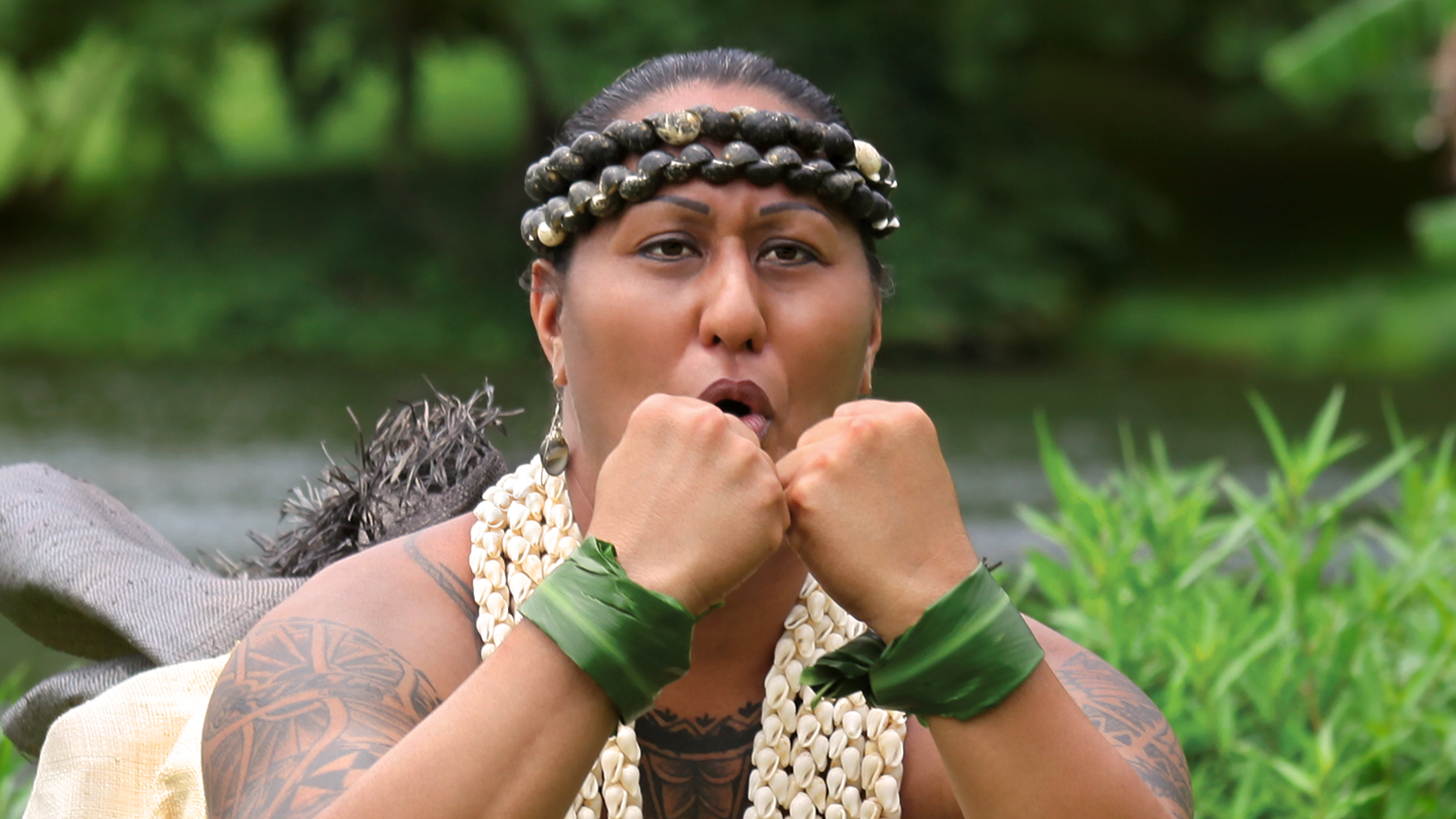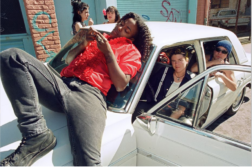THE 2014 DOCUMENTARY film Kumu Hina follows the life of Hinaleimoana Wong-Kalu—called simply “Hina”—a modern Hawaiian Māhū and a proud transgender woman. Through the lens of Hina’s life we catch a glimpse of the revered and sacred role of Māhūs in Hawaiian culture. The film encourages us to question the way in which gender is constructed and played out in our own cultural traditions, and how this Hawaiian construct challenges modern understandings of gender. Hina is portrayed as a strong and capable person, who has a full and culturally relevant understanding of self and gender. While she talks of discrimination and the challenges of her life as a Māhū, the audience is not encouraged to pity her or to see Hina as a victim, but rather as a strong survivor and a positive example to others.
In pre-Christian Hawaii, Māhū was a category of revered and admired individuals. Māhūs were regarded as the keepers of certain customs, and they played a vital role in passing on their wisdom to the next generations through traditional practices, such as hula and chant. They were what we would term transgender, people whose gender role as socially prescribed was different from their genetically determined sex. They were seen as balanced beings who expressed their masculinity and femininity with ease and freedom. In Hawaiian mythology, the power of people who encompassed both genders can be seen in the legend of Laka, the god/dess of hula, who is believed to be a deity of mixed gender.
Other cultures around the world have recognized a roughly similar social classification. In South Asia, there were the beautiful hijras who were thought of as neither male nor female. Serena Nanda, who has investigated and written extensively about the role of hijras in traditional and modern society, argues that the hijras were seen to have sacred powers that emanated from their asexuality. They have traditionally held special roles within Indian society, performing at weddings and childbirths and serving as conduits for devotees of the mother goddess Bahuchara Mata.

On the other side of the world, in native North America, we find the alluring stories and mythologies of the “two-spirit” people. Similarly understood to possess the spirit and energy of both man and woman, the two-spirit people played an important role in healing and sacred cultural practices. People believed that the “two-spirit” energies came from the Creator and that their powers were revealed at a young age with the support and encouragement of the family and community. The history and traditions of the two-spirit peoples varied greatly among the different tribes, but their importance and position of respect in many native societies have been noted in the anthropological literature.
Moving to traditional Europe, we find in the Balkans the so-called “sworn virgins,” females who practiced male roles in society, including dress and gender-specific tasks. As the name suggests, women who decided to take on this role in the community swore an oath to be celibate for the remainder of their lives. There might have been any number of pressures from within the society that would have made this choice appealing for some women, such as avoidance of an undesirable arranged marriage or the need for male farming tasks to be carried out. Even so, for those adopting cross-gendered female roles, the motivation for doing so was seen as complex, and individual needs and understandings of self were taken into account.
Closer geographically to the Hawaiian Māhū are the Fa’afafine of Samoa. Fa’afafine, which translates to “being like a woman,” are born male but explicitly embody both male and female traits. Johanna Schmidt, in an ethnographic study of the Fa’afafine in Samoa and New Zealand, comments that “the ways in which fa’afāfine are understood as gendered is a complex and sometimes contradictory intersection of ‘males,’ ‘men,’ ‘not-men,’ ‘not-women’ and ‘like women.’” In this and in other ethnographies, we can see the complexity and fluidity of gender as it is defined within a single cultural framework.
In modern Western society, where gender is regarded as binary, the dominant ideology has been that biological sex differences dominate gender roles, and any variation from this pattern is abnormal. This idea has been challenged in recent years with the notion that gender is better conceptualized as a continuum, or even as multi-dimensional, suggesting that our binary definition is an oversimplification.
It has been argued that Māhūs historically were not viewed merely as men who dressed as women but instead as a third gender—a combination of, but distinct from, the other two. In the film, Hina declares: “My natural ways transcend, I am both.” She—and this usage is admittedly problematical, but for lack of a better word—talks about her understanding of gender and self as a fluid and dynamic property. Like her Māhū predecessors, she feels that she can express both her masculinity and femininity freely. In contrast, Western binarism has given rise to a narrative that one is “stuck in the wrong body” if anatomical sex and psychological gender do not coincide. The solution is to adopt the “opposite” gender, often embarking on a physical change with the help of modern medicine, rather than to pursue a third alternative.
Alongside the story of Hina in the film is the story of a young Māhū named Ho’onani who describes herself as “in the middle.” She, too, sees her own gender as being somewhere between male and female. The triumphant finale of the film has Ho’onani leading the male hula group with strength and passion. Hina comments that Ho’onani has great ku, male energy, and encourages her to embrace both energies that she possesses following the tradition of Māhūs in pre-Christian Hawaii.
The producers of Kumu Hina also made a shorter version of the film under the title “In the Middle” (2014) with children as the intended audience. The film facilitates a discussion of gender and variations in gender identities in an effort to reduce discrimination. Throughout the film, Hina and Ho’onani are able to use traditional concepts of gender to understand their own identities. They seem to draw strength from the traditional Hawaiian gender ideologies in forming and embracing their own sense of self. This link between the past and present is a key theme in the film, and audiences are constantly reminded that this connection to one’s ancestors and traditional practices should be revered and respected.
Gender in traditional Hawaiian culture was understood in terms of a division of labor rather than physical appearance or sexual orientation. Sexual relations with men were seen as an optional aspect of being a Māhū rather than as a defining attribute. In Western culture, gender is understood largely in biological terms—anatomy is destiny, in Freud’s formulation—and is only loosely linked to the division of labor, especially nowadays. (The notion of “women’s work” and “men’s work” seems increasingly quaint.) In Hawaii, as in many other traditional societies, gender is defined by the contribution one makes to society.
Hawaii before European contact was a society where sex was viewed without guilt or shame, and people were free to express their sexuality and gender diversity, so long as they followed the kapu rules, which comprised a code of conduct related to interactions with the gods. In the diaries of Captain Cook and the early Western visitors to Hawaii, we read of their disgust at the intimate relationships that they witnessed, especially when it came to the gender-crossing behavior like that of the Māhūs.
Much of traditional Hawaiian culture was lost or repressed following European contact, including expressions of gender diversity. With Western colonization in the 18th century and widespread efforts to replace local practices with Christian rituals, the place for Māhūs in society started to disappear. Later, Christian missionaries from the U.S. would rewrite the standards governing sexual behavior and make sure they were enforced.
It wasn’t until the 1970s that there began an era of cultural renaissance and a new emphasis on the teaching and performance of cultural traditions such as hula. Awareness and understanding of transgender experiences have greatly increased in recent years, as films like Kumu Hina, among others, have disclosed the lives and stories of transgender people. In recent years the name is beginning to have renewed importance, and more and more Māhūs are embracing the label as well as its cultural importance. In the book O Au No Keia: Voices From Hawai’i’s Mahu and Transgender Communities, Andrew Matzner interviewed many Māhūs in order to preserve their stories and share them with others. One interviewee, Kaua’i iki, says that “there was a role which we once played and still play. So I believe in my culture; I’m an accepted and an integral part of my culture.”
On the other hand, while the name Māhū has come back into the Hawaiian vocabulary, the word itself has taken on a somewhat derogatory meaning. Also, those identifying as Māhū still face discrimination, unemployment, and mental and physical health problems. It is important as we move forward that we try to build an integrated and open society that celebrates diversity as our ancestors have done across the globe. If there is something we can learn from the Māhūs and their counterparts, it is that there’s a place for the many and varied gender identities within our communities.
Eleisha Lauria, a postgraduate student in psychology, lives in Melbourne, Australia.






